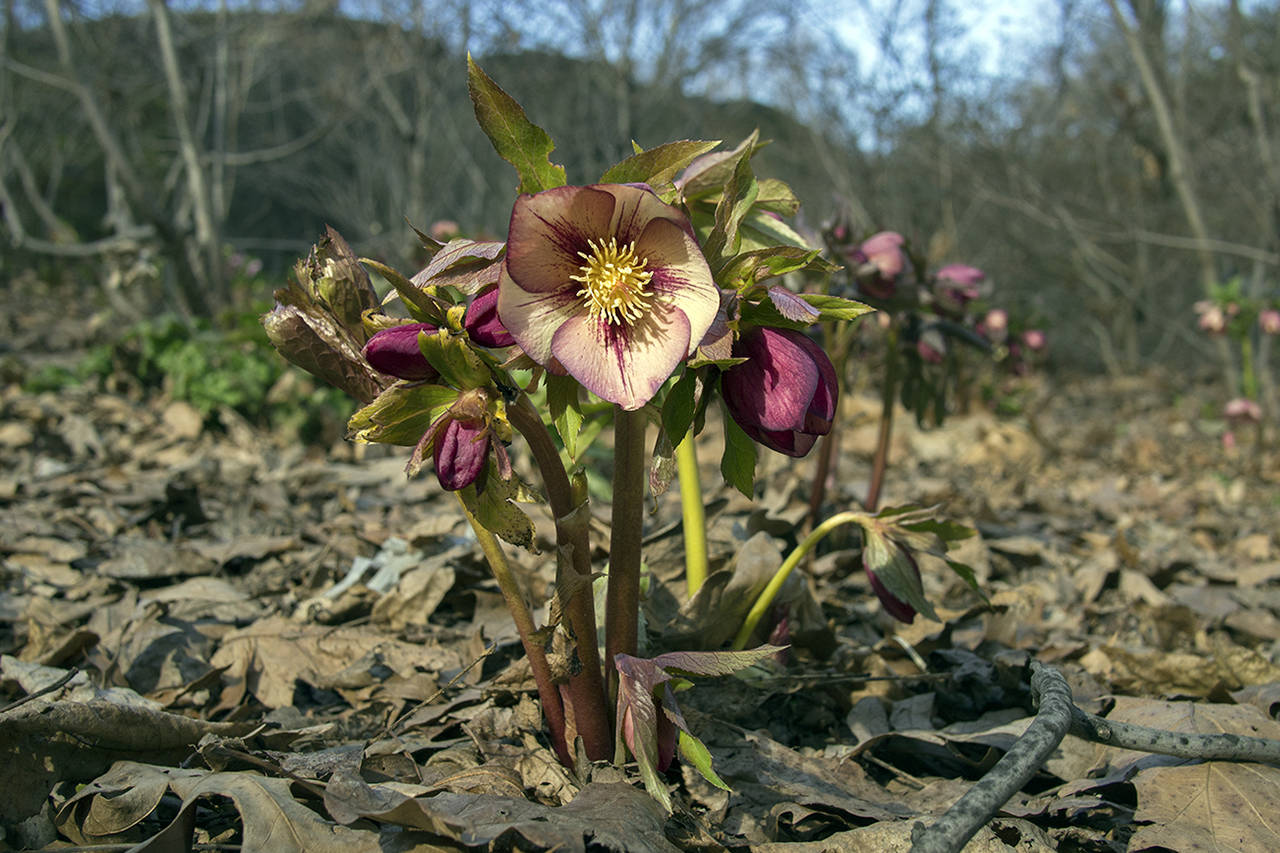By Kim Woodford
WSU Master Gardener
The first time I met a hellebore, I was going to the Seattle Center. Having parked in the garage opposite the center, I walked across the sky bridge and descended the stairs to the sidewalk that led to the common-area entrance. Through the gates were imposing aggregate concrete planters containing my soon-to-be new best friends, the hellebores.
Wow! Here it was February, and these plants were blooming in light green and pale burgundy blossoms, representing the Helleborus orientalis.
Once I learned what they were, I needed to know how to pronounce their name. Clever as they are, they picked up my name immediately; and once a plant says my name, I’m hooked. The second “e” in “hellebore” is pronounced with a short “e,” same as the first one. Now you can get off to a good start with this BPF (best plant friend).
Now, don’t run out to find a native hellebore. Not only are they not native to the Pacific Northwest, they’re not native to the USA at all. This herbaceous perennial is part of the Ranunculaceae family (as in the uninvited pernicious buttercups everywhere in our growing area). Distribution of the hellebore is from the British Isles, east through Europe and farther into Turkey and then China. But they like it here, too.
Hellebores are usually long-lived, non-finicky fellows growing in edges of woodland slopes. There are about 15 species — some say 20 — that are difficult to identify and classify, as it is documented they are variable in nature. They don’t mind acid or alkaline soils. However, their preference is deeply dug soil with a healthy helping of humus. I have grown them successfully in north-facing gardens, with bleeding heart and phlox coming on later. Others of note in the buttercup family are delphinium, clematis, anemone and columbine.
Here’s where it starts to get complicated. We’re talking spellcheck meltdown here. “Caulescent” and “acaulescent” categories of hellebores define the growth structure of the plant.
Now, this means some hellebore species are stemmed (caulescent) and some are stemless (acaulescent). The stemmed type form clumps of tall stems with evergreen leaves. In early to midwinter, “racemes” — or stems of flowers — appear. This is a one-time thing. Once it blooms, that stem will not bloom again and may be pruned from the plant in early to mid-May. Next year’s blooms will appear on new stems, which will emerge when this year’s blooms are maximized.
The stemless species, acaulescents, form leaves and flowers that arise directly from the ground. These are often called “Lenten rose,” because the plants flower in early spring and the flowers resemble a rose bloom (though they are not related). Some of these hellebores are the now-popular “Helleborus × hybridus,” found in a wide range of colors at local nurseries in the winter months. To enjoy these flowers better, folks like to cut the leaves back in early late fall or early winter, allowing the new growth to dominate and to get rid of leaves damaged by disease.
The best time to shop for hellebores is in February and March, when the selection is largest and the plants are in flower. So, note the names of your special picks.
Keep an eye out for hellebore sales from April onward as their flowering season winds down. Selection is smaller, but this is a great time to pick up a bargain. You’re good to go with your list of names!
Be forewarned: As is the case with humans, hellebore offspring do not always look like Mom. In the garden, with bees as prolific pollinators, Helleborus x hybridus seedlings will have the best chance of resembling the parent if similar colors are planted together in the garden. While color blending can yield a few interesting seedlings, it might also yield quite a few muddy-colored hybrids.
That’s the buzz on Hellebores!
Kim Woodford, WSU Master Gardener Class of 2016, gardens in Westport. To learn more about the WSU Master Gardener Program in Grays Harbor and Pacific Counties, visit PNWMG.org. Mark your calendar for the Grays Harbor Home and Garden Show May 18-19.


